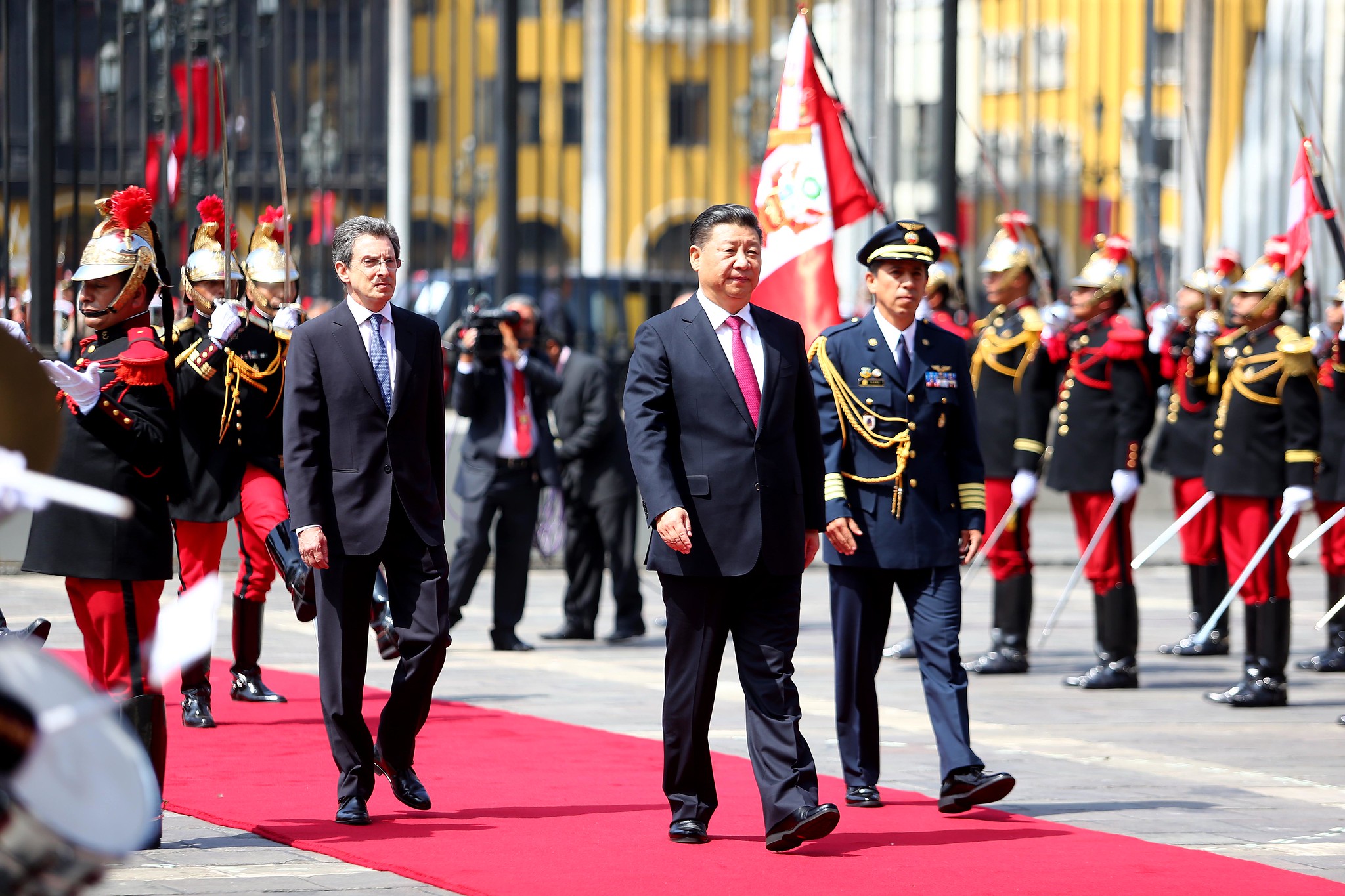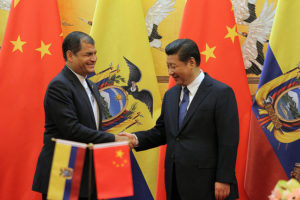Rarely a week passes without Chinese media celebrating the “win-win” potential of China’s relationship with Latin America – or a story appearing in Western media questioning whether it constitutes a threat to US interests in its pejorative “backyard”.
Chinese president Xi Jinping’s recent trip to the 2016 APEC summit in Lima, Peru, caused the latest surge in media interest, along with China’s Ministry of Foreign Affairs (MFA) issuing a new policy document reaffirming its commitment to Latin America. Such documents are important because they act as a compass orienting experts and public officials as to China’s long-term plans for the region, Paulina Garzón of the China-Latin America Sustainable Investment Initiative, told Diálogo Chino.
There have now been two MFA policy documents for Latin America. The ministry released the first in 2008. Analysts have noted the careful timing of Xi’s visit and the new policy announcement. The first White Paper was released just after the US Presidential elections, as was the second, says Gonzalo Paz, an expert in China-Latin America relations from the US-based Wilson Center. Paz added that while Chinese policymakers did not want to have their policy announcements overshadowed by the elections, they also signal their intentions to the new US administration.
As the large quantity of column inches devoted to the subject attests, China’s latest show of interest in Latin America, complete with declarations on growing trade and building infrastructure in the region, undoubtedly has big, if sometimes overstated, geopolitical implications. Yet significantly less attention has been paid to the advances and ongoing challenges it represents for delivering socially and environmentally sustainable development in the region. This is despite frequent promises from both sides to diversify a relationship heavily focused on trade in a handful of raw materials and the construction of big, often controversial, infrastructure projects.
A step forwards
“The 2016 white paper is a step forwards,” according to Garzón, who said the document’s references to the implementation of “sustainable and equitable” development in Latin America are promising. She added that this can be achieved by setting out ambitious targets for stemming the flow of finance towards high-polluting industries and establishing a formal mechanism for informed and participative dialogue on the impacts of infrastructure and extractive projects.
In contrast to the 2008 White Paper, the new document states the Chinese government’s intention to cooperate with Latin American and Caribbean countries within United Nations frameworks. Through the internationally-agreed 2030 Agenda for Sustainable Development, which was adopted in the interim, it aims to: “promote global, win-win cooperation”. It also reaffirms its commitment to the Paris Agreement on climate change.
However, Guy Edwards, research fellow at Brown University, said these references are largely symbolic. As such, he says the White Paper represents a “missed opportunity” since its general, somewhat “traditional” tone fails to capture China’s new leading role in advancing clean energy globally. This leadership, he adds, can play an important role in helping Latin American countries meet their pledges under the Paris Agreement.
Garzón argues that the Paris Agreement is an imperfect foundation on which to base cooperation on climate and environment since it does not include directives on green finance. China Development Bank, the largest institutional lender to Latin America, has yet to publish any social or environmental standards for its investments, rendering the effective “greening” of Chinese finance in the region impossible.
Chilean president Michelle Bachelet expressed her support for joining the China-led Asian Infrastructure Investment Bank, which began operating earlier this year. The bank’s remit is to support infrastructure lending through China’s One Belt One Road initiative but has been rumoured to want to expand its portfolio into Latin America. The bank has been under pressure at home and from international groups to adopt a sustainable lending framework.
Wu Guoping, director general of the Center of Latin American Studies at Southwest University of Science and Technology, doesn’t see the AIIB supporting green, or any other kind of development in Latin American any time soon since Asia remains its principal focus. Chinese companies need more experience navigating Latin America’s land, labour and environmental laws before further large-scale investment in infrastructure, he told Diálogo Chino.
While there’s work to do in greening finance, there have been important advances in environmental policies in other sectors.
Within the past two years, Chinese regulators have introduced new social and environmental standards for their overseas mining operations which, according to Garzón, are more advanced than others that are applicable internationally. Guidelines on supply chain due diligence issued by China Chamber of Commerce of Metal, Minerals & Chemicals Importers & Exporters (CCCMC) not only stipulate that extractive projects must count on the prior and informed consent of affected parties, they also establish “no-go zones” in the name of social and environmental protection.
Though these guidelines are not binding, CCCMC has committed to their full implementation within three years and has set up both a training programme and a monitoring mechanism to ensure mining companies adhere to them.
Meanwhile, conflicts over resources persist on the ground. Nowhere more so than in Peru where 97 of the country’s 149 ongoing socioenvironmental conflicts are linked to mining, according the latest figures from the Ombudsman (Defensoría del Pueblo). While foreign companies from Europe and North America have also experienced disruptions and protests, flagship projects such as the Chinese-owned Las Bambas copper mine, one of the world’s largest, are seen as important test cases for conflict resolution.
Mine owner China Minmetals (MMG), the government and local communities recently came together to try and settle disputes over the distribution of benefits generated by the project and the impacts of the transportation of industrial materials through their villages. This, they complain, was omitted from the project’s environmental impact assessment (EIA).
Enforcing environmental laws, which include the production of EIA’s and eliciting feedback on them, remains the responsibility of host governments. Peruvian President Pedro Pablo Kucynski, who has expressed his intention to work closely with China on mining, said the claims of Las Bambas protestors were legitimate and recently ordered the submission of a new impact study.
Wu Hongying, director general of the Latin America Center at the China Institute of Contemporary International Relations, told Diálogo Chino that while environmental regulations differ across Latin America, they are generally relatively sound. Complying with these and delivering social benefits will improve Chinese companies’ chances of winning contracts.
Wu added that Chinese companies are also under pressure to meet higher corporate social responsibility standards and said they are increasingly recognising the costs of not understanding local environmental laws.
Two-way conversation?
China’s effusive overtures towards Latin America have yet to receive any coordinated regional response and it is uncertain where this would come from since the MFA’s White Paper does not identify any individual countries. It does, however, refer to the establishment of the Forum of China and the Community of Latin American and Caribbean States (China-CELAC Forum), which has “provided a new platform for cooperation between the two sides, setting the course for simultaneous and complementary development of bilateral and collective cooperation”.
CELAC is a 33 country-strong Western hemispheric bloc which excludes the US and Canada. Paz said this is the most appropriate mechanism through which Latin American countries can articulate their interests.
According to Edwards, CELAC also appears to be China’s preferred platform. However, as it has no secretariat and has struggled to reach consensus between its members, the forum’s current institutional capacity is limited and Latin American countries and civil society groups urgently need to make their voices heard.
One area seemingly not up for discussion in the conversation prompted by the White Paper is the cancellation of debt owed by Latin American governments. According to Garzón, this is a notable omission compared to the 2008 document, which declares: “The Chinese Government will, based on its consistent policy on debt reduction and cancellation, discuss with relevant Latin American and Caribbean countries ways to relieve their debts as China’s ability permits”.
“It’s shocking that Latin American governments, especially Ecuador and Venezuela, have not invoked this position given their high levels of debt with China,” she said.








